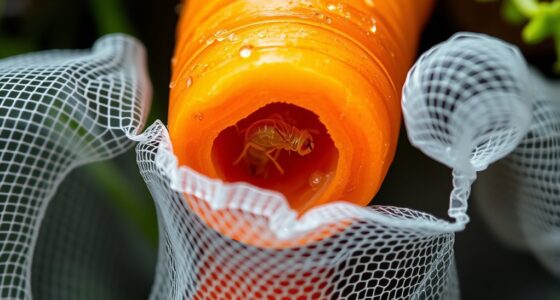To tell bean beetles apart from lady beetles, look at their size and shape—bean beetles are elongated and about 4-6 mm, while lady beetles are rounder and slightly larger. Notice their color and markings; lady beetles are bright red or orange with black spots, while bean beetles tend to be duller yellow or light brown with subtle lines. Pay attention to their habitats and movement—bean beetles stay close to beans and move slowly, whereas lady beetles are more mobile. Keep exploring for more tips!
Key Takeaways
- Bean beetles have elongated, narrow bodies (4-6 mm) with duller colors, while lady beetles are rounder, bright red or orange with black spots.
- Lady beetles feature shorter, rounded wings and shorter, robust antennae; bean beetles have longer, tapered wings and slender antennae.
- Bean beetles prefer bean plants, crawling slowly, while lady beetles are more adaptable, often flying rapidly in groups to seek aphid prey.
- Visual markings: lady beetles display bold black spots on colorful shells; bean beetles have subtle lines or spots with duller hues.
- Behaviorally, lady beetles migrate seasonally in groups with warning coloration, whereas bean beetles stay localized near host plants, using chemical defenses.
Visual Differences in Size and Shape

While bean beetles and lady beetles may seem similar at a glance, you can tell them apart by their size and shape. Bean beetles are generally more elongated and narrower, with a body length of about 4 to 6 millimeters, giving them a slender appearance. Lady beetles, on the other hand, tend to be rounder and more compact, usually measuring around 5 to 8 millimeters. The wing structure also differs: lady beetles have shorter, more rounded wings that fit snugly against their bodies, while bean beetles have longer, more tapered wings that extend beyond their bodies when at rest. Additionally, the antenna length varies; lady beetles have shorter, more robust antennae, whereas bean beetles sport longer, more slender antennae that are easily noticeable. Physical characteristics such as body shape and wing length make these insects distinguishable at a glance.
Coloration and Patterning Characteristics
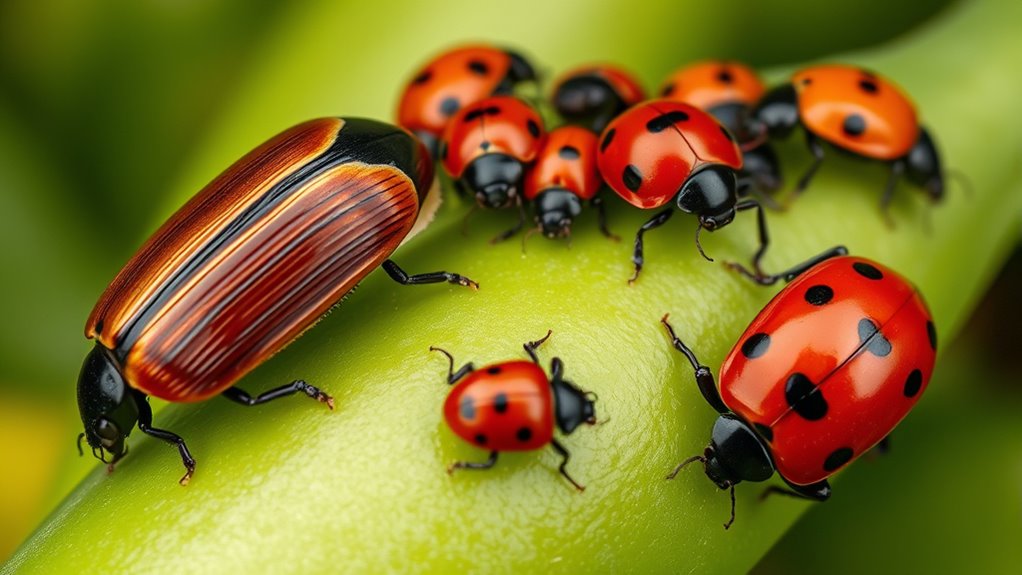
Bean beetles and lady beetles display distinct coloration and patterning that make them easy to tell apart. Lady beetles usually feature bright red or orange shells with black spots, which serve as a warning of plant toxicity and help in predator avoidance. In contrast, bean beetles tend to have a more uniform, duller coloration—often yellow or light brown—without prominent spots. Their less conspicuous appearance reduces the chances of attracting predators, especially since they rely less on warning signals. These color differences are adaptations to their survival strategies: lady beetles use bold patterns to warn predators, while bean beetles blend in with their surroundings. Recognizing these contrasting coloration and patterning characteristics helps you distinguish between the two beetle types easily. Additionally, understanding their warning signals can provide insights into their respective defense mechanisms and ecological roles.
Distinctive Markings and Spots
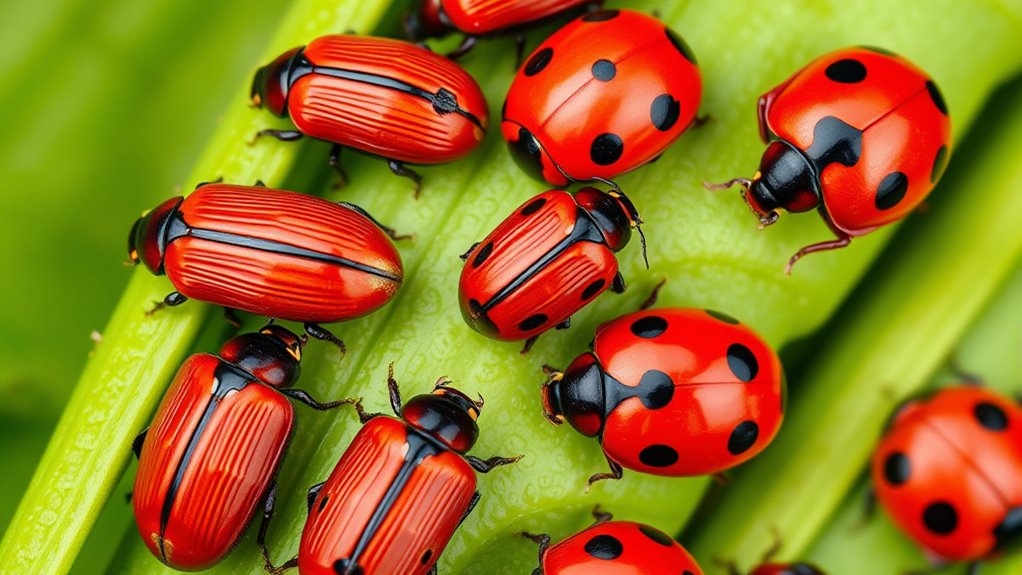
You’ll notice that bean beetles and lady beetles have unique markings and spots that help distinguish them. Their color patterns and spots vary, making each species identifiable at a glance. Pay attention to their shapes and markings to tell them apart more easily.
Color Patterns and Spots
Color patterns and spots are key features that help distinguish bean beetles from lady beetles. Bean beetles typically have a uniform, dull tan or reddish color with few markings, while lady beetles display vibrant reds, oranges, or yellows with black spots. Their wing structure also varies; lady beetles have short, rounded wings with clear spotting, whereas bean beetles possess longer, more cylindrical wings suited for feeding habits on beans. To visualize:
| Bean Beetle | Lady Beetle |
|---|---|
| Dull tan or reddish, smooth | Bright red, dotted with black |
| Elongated, less colorful | Compact, boldly patterned |
| Wing structure suited for feeding | Wing structure for quick flight |
These differences highlight their unique markings, making identification easier. Additionally, understanding insect physiology can further aid in accurate identification.
Shape and Markings
While shape and markings are key to telling these beetles apart, their distinctive features are immediately noticeable. Bean beetles typically have elongated bodies with smooth, shiny surfaces, whereas lady beetles are rounder and domed. In terms of markings:
- Bean beetles often display subtle, light-colored lines or spots along their backs.
- Lady beetles usually have bright red or orange bodies with black spots, sometimes just one or two.
- Their feeding habits influence their appearance: lady beetles feed on aphids and have a more rounded shape to access prey easily, while bean beetles tend to have more streamlined bodies suited for burrowing into beans.
- Additionally, family classification helps differentiate them, as bean beetles belong to the Bruchidae family, whereas lady beetles are part of the Coccinellidae family.
Migration patterns also affect markings; lady beetles migrate in large groups, leading to uniform appearances, while bean beetles stay localized.
Mouthparts and Head Features
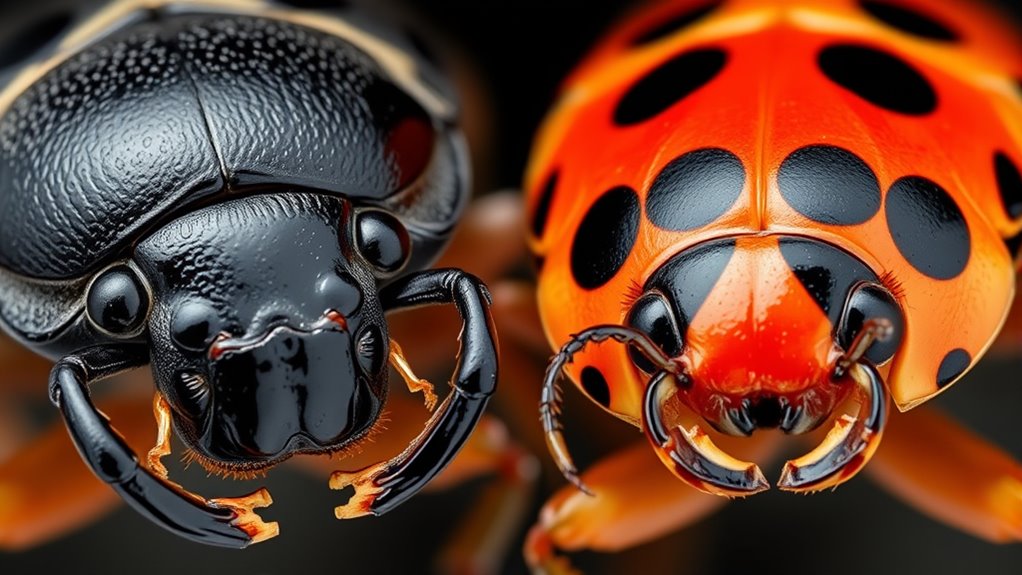
You’ll notice that bean beetles and lady beetles have different mouthparts designed for their diets. Their head shapes and sizes also vary, affecting how they feed and move. Examining these features reveals key differences in how each insect interacts with its environment.
Mandible Structure
The mandibles of bean beetles and lady beetles are essential tools for feeding and defense, but they differ markedly in structure and function. Your eye might notice that bean beetles have strong, curved mandibles built for chewing, while lady beetles sport more delicate, jagged mandibles suited for piercing and tearing.
- Bean beetles: Thick, robust mandible structure, ideal for grinding plant material.
- Lady beetles: Sharp, jagged mandibles designed for piercing prey.
- Feeding mechanisms: Bean beetles crush and chew their food, whereas lady beetles pierce and suck fluids.
These differences in mandible structure directly influence how each beetle feeds, with bean beetles focusing on plant matter and lady beetles on prey, shaping their feeding behaviors profoundly. Mandible structure plays a crucial role in determining the feeding strategy and ecological niche of each beetle.
Head Shape and Size
Bean beetles and lady beetles exhibit notable differences in head shape and size that reflect their feeding habits. Bean beetles have a more elongated head with a narrower profile, supporting their specialized mouthparts for feeding on legumes. In contrast, lady beetles possess a broader, rounded head with prominent mandibles suited for varied prey. You’ll notice that antenna length also varies: bean beetles tend to have shorter antennas, while lady beetles often have longer, more segmented antennae for sensing their environment. Leg coloration can be a helpful clue too, as it often matches the head’s tone, aiding in species identification. These head features reveal much about their dietary preferences and behaviors, making head shape and size a key factor in telling these beetles apart. Additionally, the head structure influences their feeding techniques and ecological roles within their habitats.
Habitat Preferences and Host Plants
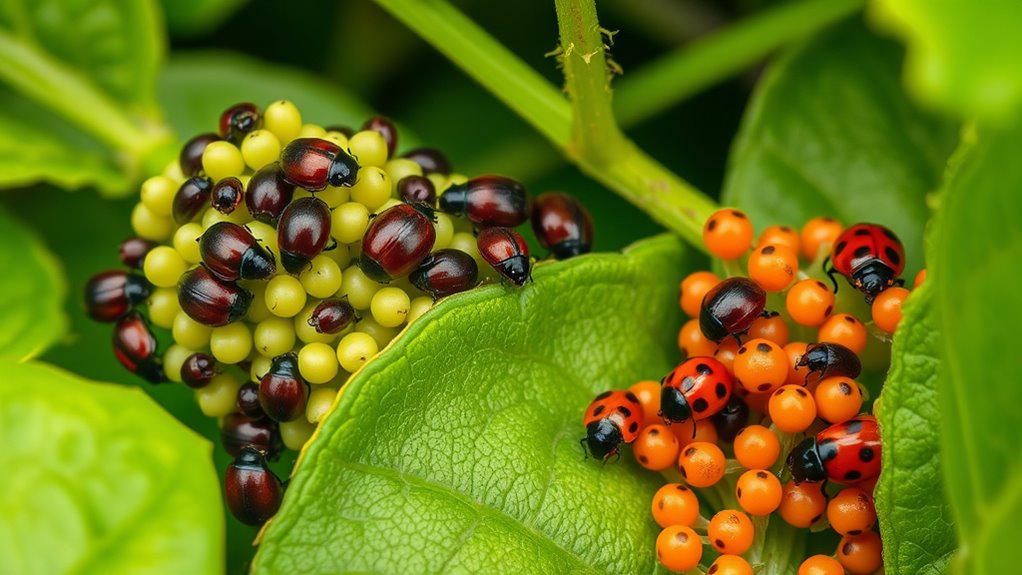
While both bean beetles and lady beetles are found in similar environments, their habitat preferences and host plants differ considerably. You’ll notice bean beetles primarily choose leguminous plants, especially beans, for their host plant preferences. They tend to stay close to their food source, often within bean fields or gardens. Lady beetles, on the other hand, are more adaptable in habitat selection, inhabiting a variety of environments such as gardens, forests, and fields. They prefer plants like aphid-infested crops, which serve as their main food source. To visualize this:
- Bean beetles cling tightly to bean pods, nestled among leaves
- Lady beetles crawl across a range of plants, searching for aphids
- Both insects frequent lush, green environments but differ in plant choices for feeding and breeding
- Habitat diversity allows lady beetles to thrive in various ecosystems, unlike the more specialized bean beetles.
Behavior and Movement Patterns

Bean beetles tend to move slowly and intentionally, often staying close to their host plants for feeding and breeding. They rarely wander far, preferring to remain near food sources. When threatened, they may release chemical defenses to deter predators, signaling their unpalatability. During mating behaviors, males often engage in specific courtship rituals, such as antennal touches and displays, to attract females. These behaviors help ensure successful reproduction while conserving energy through deliberate movements. Unlike lady beetles, bean beetles don’t exhibit rapid flight or erratic movements; instead, they move purposefully, which makes them easier to observe. Their movement patterns reflect their strategy for survival—staying close to food and using chemical defenses to avoid predation.
Impact on Garden Crops and Plants
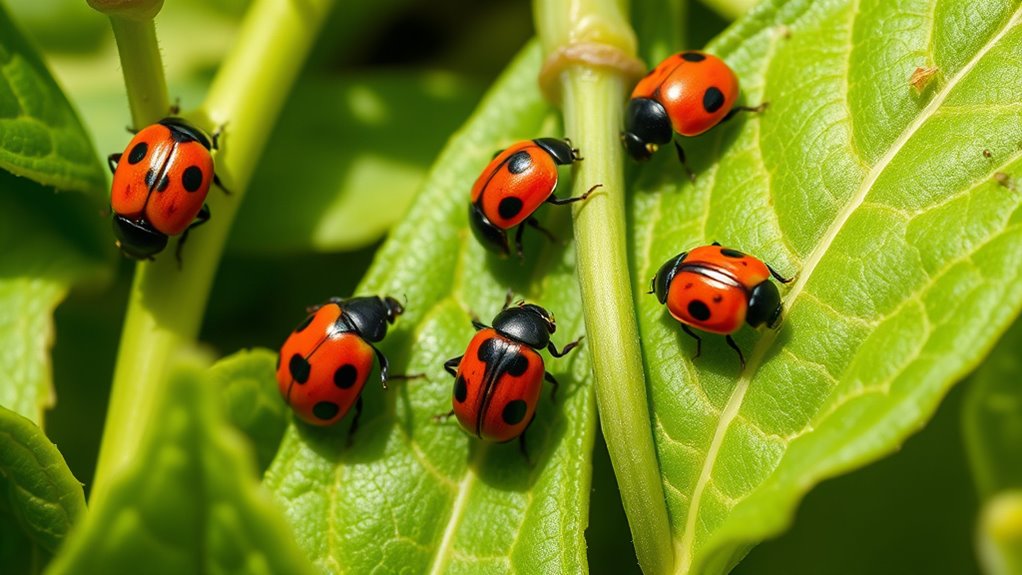
The movement and behaviors of bean beetles directly influence their impact on garden crops and plants. As they crawl and feed, they can cause significant damage, making your plants look unhealthy or stunted. You might notice:
- Tiny holes and chewed leaves revealing the plant’s interior
- Yellowing or wilting stems from weakened structures
- Pods with damaged or missing beans, reducing harvest yield
Their presence challenges garden pest control efforts, requiring targeted actions to minimize damage. While bean beetles harm legumes, lady beetles play a beneficial insect role by preying on pest insects. Recognizing their behaviors helps you protect your crops effectively, encouraging natural pest management techniques and promoting a healthy, balanced garden ecosystem. Additionally, understanding pest management strategies can improve long-term pest control success and reduce chemical use.
Life Cycle and Reproductive Habits
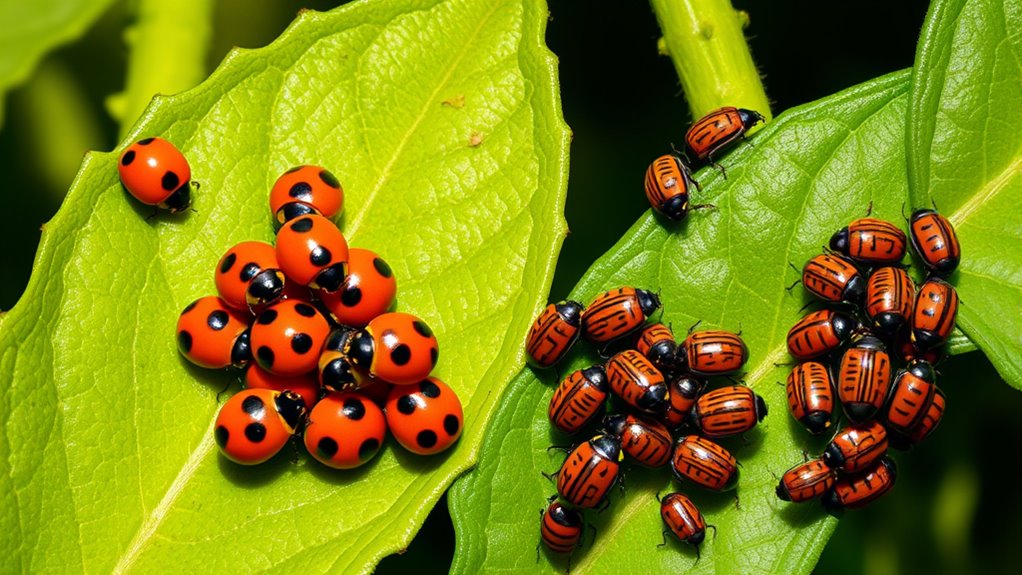
Understanding the life cycle and reproductive habits of bean beetles is essential for effective management. These beetles employ specific reproductive strategies, laying their eggs directly on or near bean plants. The female beetle’s egg laying habits involve depositing small clusters of eggs, often on the undersides of leaves, where they’re protected and accessible for hatching. After about a week, larvae emerge and begin feeding on the beans, progressing through several instars before pupating. The entire life cycle from egg to adult typically takes around three to four weeks, allowing multiple generations per season. Recognizing these reproductive habits helps you anticipate infestations and implement timely control methods. By understanding their life cycle, you can better disrupt their reproductive process and protect your crops effectively. Understanding their reproductive strategies can help you develop more targeted pest management techniques.
Tips for Accurate Identification
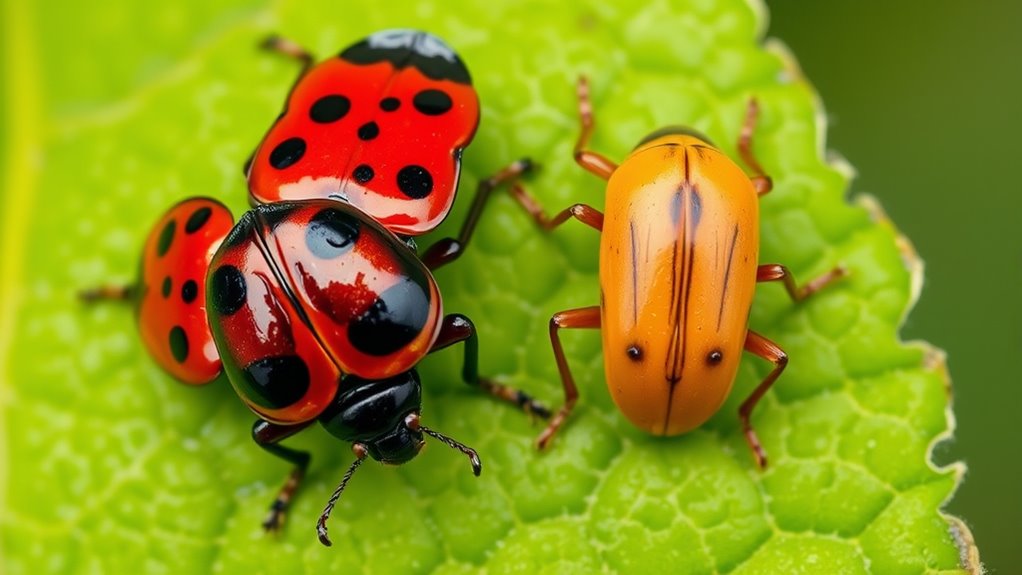
Accurately identifying bean beetles and lady beetles is essential for effective pest management. Recognizing their differences helps prevent unnecessary crop damage and targets treatments during peak seasonal activity. Focus on these tips:
Accurate identification of beetles prevents crop damage and targets treatments effectively.
- Observe color and markings: bean beetles typically have a shiny, reddish-brown shell with black spots, while lady beetles often display bright red or orange bodies with black spots or markings.
- Check size and shape: bean beetles are slightly larger with a more elongated body, contrasting with the rounded shape of lady beetles.
- Monitor activity timing: bean beetles tend to be active during warmer months, especially when beans are growing, whereas lady beetles are more widespread but also seasonal.
Using these tips ensures accurate identification, reducing crop damage and improving pest control timing.
Frequently Asked Questions
Are Bean Beetles and Lady Beetles Beneficial or Harmful to Gardens?
You’re wondering if bean beetles and lady beetles are beneficial or harmful to your garden. Lady beetles are beneficial insects, helping with pest control by eating aphids and other pests. However, bean beetles are harmful pests that damage beans and other legumes. Knowing the difference helps you protect your garden effectively. Encourage lady beetles for natural pest control and take action against bean beetles to prevent crop damage.
How Long Does Each Beetle Species Typically Live?
You might wonder about beetle lifespan and insect longevity. Typically, bean beetles live around 3 to 4 weeks, while lady beetles can live up to a year, depending on conditions. The short lifespan of bean beetles limits their impact, whereas lady beetles’ longer life allows them to control pests effectively. Keep in mind, environmental factors can influence these durations, but generally, this is what you can expect for each species.
Can Bean Beetles and Lady Beetles Interbreed?
You might wonder if bean beetles and lady beetles can interbreed, but generally, beetle hybridization is unlikely due to interbreeding barriers like differences in mating behaviors and genetic compatibility. These barriers prevent successful interbreeding, so hybridization between the species rarely occurs. Even if they do attempt to mate, their genetic differences usually stop viable offspring from developing, maintaining distinct species boundaries.
What Natural Predators Target Each Beetle Species?
In predator-prey relationships, both bean beetles and lady beetles face natural predators, but their ecological roles differ. Lady beetles are often preyed upon by birds, spiders, and larger insects, helping control pest populations. Bean beetles, on the other hand, are targeted by parasitic wasps and predatory insects. Understanding these predator-prey dynamics highlights their ecological roles in maintaining balanced ecosystems and natural pest regulation.
Do Environmental Conditions Influence Their Appearance or Behavior?
Environmental effects markedly influence beetle appearance and behavior. You’ll notice seasonal behavior changes, such as increased activity in warmer months and dormancy during cooler periods. Variations in temperature, humidity, and food availability can cause physical differences, like size or color shifts. These environmental conditions prompt adaptive responses, helping beetles survive. So, pay attention to seasonal cues and environmental factors, as they shape how these beetles look and act throughout the year.
Conclusion
By paying close attention to their size, color, markings, and habits, you can confidently tell bean beetles apart from lady beetles. Think of them as characters in a story—each with its own unique traits—and learn to recognize their roles in your garden. Mastering these differences helps you protect your plants effectively. So, the next time you see a beetle, ask yourself: is this a helpful lady or a pesky bean beetle ready to cause trouble?



